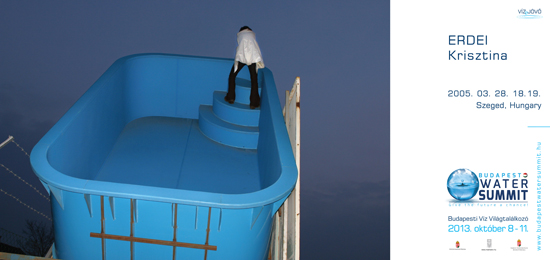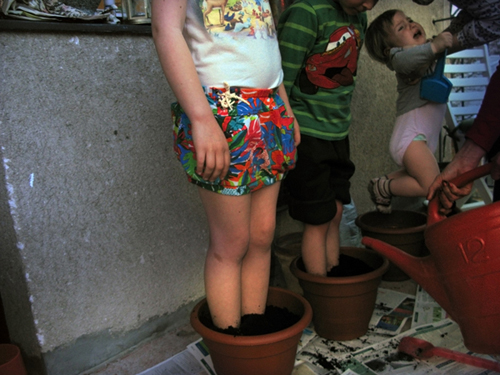Erdei Krisztina: Anti-glamour
Godot Galéria, 2012. I. 12–II. 11.
Bordács Andrea írása
Hibátlan női testek, arcok, sejtelmes tekintetek, csábító ajkak a tökéletes minőségű fotókon frusztrálják a nők ezreit, akik hiába igyekeznek, mégsem sikerül ilyen glamourosra formálni magukat. Az 1920-as évek óta új, a szépség igézetében fogant valóság szövi át – elsősorban a női – vágyakat.
Ugyanakkor ma már nemcsak a modell szépségét kihangsúlyozó, enyhén – vagy épp kevésbé enyhén – erotikus fotókat értünk alatta, mint eredendően, hanem elsősorban e fotók keltette életvitelt és annak az illúzióját. Pontosabban a luxust, a kifinomult jó ízlést, ami persze gyakran kapcsolatban van a legújabb divattal és trendekkel. Már amennyiben a luxus, a jó ízlés valóban ezt jelenti. Hisz a jó ízlés David Hume-nál még nem divathoz vagy változékony szépséghez kötődik, hanem egy általánosabb értelemben vett szépérzékhez. „Sokan nyilvánvalóan azért nem érzik a szépség megfelelő érzetét, mert híján vannak a kifinomult képzelőerőnek, mely nélkülözhetetlen ahhoz, hogy az ember e nemesb érzékek iránt fogékonnyá váljon. E finom érzékről mindenki azt állítja, megvan benne, mindenki erről beszél, s mindenféle ízlést és véleményt ennek mércéje elé állít.”[1]
Ám néhány évtized múlva úgy tűnik, a szépség kritériuma sokkal konkrétabb formát ölt, s noha a 19. század elején sem használták még a glamour fogalmát, ennek ellenére valamiféle új ideál megfogalmazására törekedett lord Byron is, amikor kijelentette, „mely szerint egy nőt sohasem szabadna nyilvánosan enni vagy inni látni, hacsak nem homársalátáról és pezsgőről van szó: az egyetlen nőies és illendő fogásról.”[2]
Az idők változását jól szemlélteti, hogy korunk jelenségeit bizarr módon leíró regényében Pelevin a modern kultúra két tartópillérének a glamourt és a diskurzust nevezi. Ráadásul e két fogalom segít egymás meghatározásában, ugyanis az ő megfogalmazásában a „glamour a test diskurzusa…”, míg a diskurzus „a szellem glamourja”[3]. Bár valljuk be, az, hogy mit és hogyan mondunk, mégiscsak jobban definiál minket, személyes brandünk része, mint a divat változó szeszélyének sikeres vagy sikertelen követése. Ugyanakkor nemcsak a dizájn, hanem valamelyest a beszédmód is divat-, vagy talán inkább korfüggő. A glamour: a luxus, a menő, a divat, a trendi, pontosabban nem is divatkövető, hanem divatalakító. És ami nem ilyen, az ciki, égő, azaz antigalmour.
A nemzetközi terepen[4] is nevet szerzett fiatal fotósunk, Erdei Krisztina legújabb sorozatában épp ezeket a trendiségnek ellentmondó vagy épp azt olcsón majmoló jelenségeket veszi kamerája céltáblájául. Mintha a privátfotó hagyományát követné dokumentarista gyökerekkel keverve, de mégis elvetve a szokásos fotográfiai látás- és képkezelési módot. Erdei azon generáció alkotója, akik „radikálisan szakítottak a magyar dokumentarista fotográfia már vagy másfél évtizede tartó, fekete keretben szenvelgő helyben járásával, és újraértelmezték a saját élettér és identitás megjelenítését.”[5]
Erdei fotóiból teljesen hiányoznak a szociofotók vizuális és tematikai közhelyei, képei azon privátfotókat idézik, melyek az emlékezésnek a kukában landoló változataihoz hasonlatosak, az elcsúszott kompozícióknak, a levágott fejeknek, az előnytelen beállításoknak spontán és véletlenszerű rögzítései. Ezen látszólagos véletlenek révén születő látványok, a kiállított fotók mégis új valóságot teremtenek. Erdei korábbi képeire az ellenkező irányú folyamat, mégpedig a képpé konstruált vágyak látványa volt a jellemző, ám ezeknek a valóságkreaciónak a glamouros magazinok képi világa a nagymestere, amit képileg szinte lehetetlen túlszárnyalni. Mostanra viszont az ideálvilág helyett a make-up nélküli valósággal szembesülhetünk.
Így vált az új sorozatának fő témájává az antiglamur: a kisszerűség, az olcsóság (mint Dollyval susogós joggingban pózolni, rózsaszín műszőrme kabátra pink selyemblúzt húzni, a szőrös hónaljjal villogni, karácsonyfát társasjátékkal díszíteni stb.). Ugyanakkor a látványhoz való viszony eléggé összetett, hisz a képein az ízléstelenség megmutatása éppúgy szerepet kap, mint az átlag ember lehetőségeinek, valós életformáinak (pl. hajcsavaróban nyilvános térben mutatkozni) bemutatása, de nem szociografikus szempontból. Gyakorlatilag tág értelmű vizuális kultúránk katasztrofális állapotának egyszerre kritikusan és empátiával való kezelése ez, hisz a glamour-életformát igen kevesen engedhetik meg maguknak. Ráadásul mivel ez sokkal inkább a divathoz, mint a jó ízléshez köthető, valójában azt is legalább annyi iróniával illeti.
Erdei képeinek témája maga a tökéletlenség, mégpedig több síkon is, mind az ábrázolt életvitelben, mind a képalakításban. A látszólag véletlenszerűen készült képek akaratlanul is szemléltetik e luxus nélküli életsorsokat, sőt olykor kifejezetten a nyomor terepeit, melyek nem szociológiai, hanem vizuális szempontból kerülnek most a fotós kamerája elé. Így a stílustalanság, az ápolatlanság, a rossz ízlés, a szűkös lehetőségek tablójának lehetünk tanúi. (Mellesleg az Erdei fotóján látható, megnyitón táplálkozó nőtől Byron biztos rémülten menekülne.) A képek legfőbb erénye épp az ezekből adódó kendőzetlenség, természetesség.
Pelevin is utal rá, hogy a glamour szó jelentése varázslat, s maga az átöltözés és az álcázás nem puszta technikai kérdés, hanem a kifejezés egyetlen valós tartalma. Így már messze nem a jó ízlést jelenti, hanem egy valóságimplantátumot. Erdei viszont az ettől megfosztott világot tárja elénk humorral és empátiával.
Úgy tűnik, mintha egy új trendet hozna létre, ahol a glamour az antiglamour. Erdeinél ez a tökéletlenség a maga kisszerűségével egyszerre válik nevetségessé és – valljuk be! – némileg vonzóvá, legalábbis bájossá, de mindenképp tolerálhatóvá.
[1] David Hume: A jó ízlésről. Fordította Takács Péter, in: David Hume összes esszéi I., Bp., Atlantisz, 1992
[2] Így fogytak a hírességek. Múlt-kor .Történelmi hírportál. 2012. január 24.
[3] Viktor Pelevin: Empire ’V’. Elbeszélés a valódi felsőbbrendűemberről. Európa Kiadó, Bp., 2008, 70-71
[4] 2010-ben jelölt volt a Paris Photo fődíjára is.
[5] Jokesz Antal: A második nem beelőz. Erdei Krisztina fotói. Új Művészet, 2008/2, 41







